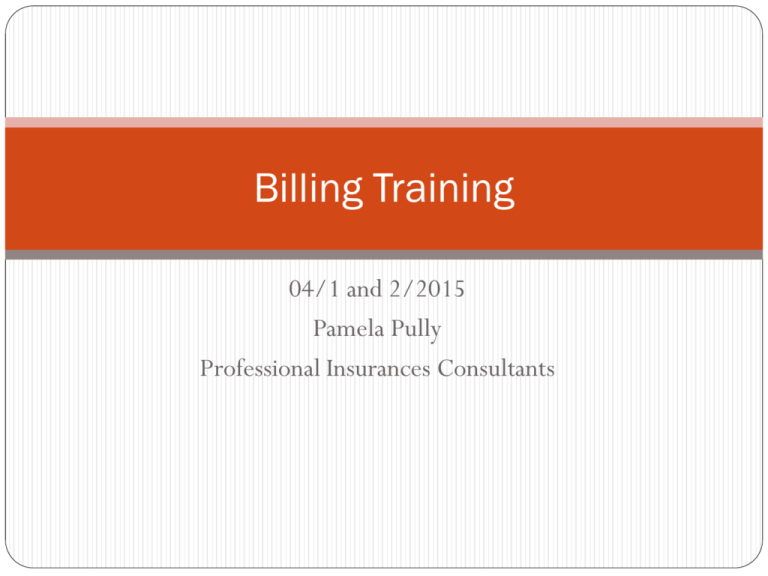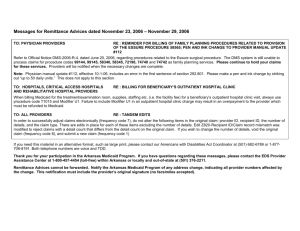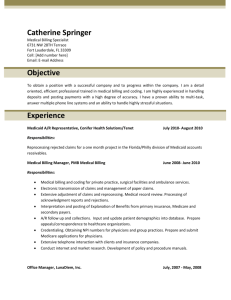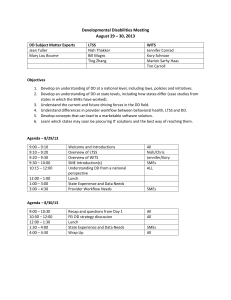E-M Billing Training April 2015
advertisement

Billing Training 04/1 and 2/2015 Pamela Pully Professional Insurances Consultants Disclaimer This information is accurate as of March 30, 2015 and is designed to offer basic information for coding and billing. All information is based on experience, training and has been researched, interpreted and carefully reviewed by this trainer. Medical compliance/coding and billing information changes quickly. This can become outdated . This is training is intended to be an educational guide and should not be considered as legal or consulting opinion. Disclaimer cont. CPT, HCPCS, ICD-9 and NCCI edits books and web-sites were used for coding information. Rules used come from AMA, ICD-9,CMS, final rule, WPS, CMS and others. HIPAA and PPACA laws considered. Any questions on information I am presenting, please ask. I will give you the source document I used. It is important to me to give the best and most up to date information I can. Medicaid for behavior health Need to make sure you review the cost per code list and qualification lists often. They can be found at www.michigan.gov watch you dates for valid information. Let review where this is at. You also must follow all rules in the Medicaid manual. Don’t forget the DCH-OIG looks to insure you are following all these rules. Medicare “incident to” www.wpsmedicare.com WPS PSY014 and 12 CMS L30489 and L30715 Private office and clinic rules are different. J-code rules under “incident to” Modifier to help with when there is no provider on site no “incident to” . When to use modifier RD. NCCI EDITS http://www.cms.gov/Medicare/Coding/NationalCorrectC odInitEd/NCCI-Coding-Edits.html Need to understand how to read the chart First you need to make sure you are in the right quarter. They change the first of every yearly quarter. Look for your primary code then second code your billing for same billing provider/same group provider.You may have to look both ways. If the code is present you can not bill together. If there is an */1 that means maybe you can bill if you have a proper modifier. There can be many to choose from. Modifiers commonly used for proper explanation of same day services Modifier 25-Most over used and effective modifier, when used under the definition: Significant, separately identifiable evaluation and management service by the same physician or other qualified health care professional on the same day of the procedure or other service. Modifier-59 Also over used and effective, when used under the definition: Distinct procedural service. Modifier 59 now has defined even more. Modifier-59 is Expanding XE (Separate Encounter). A service that is distinct because it occurred during a separate encounter. XS (Separate Structure). A service that is distinct because it was preformed on a separate organ/structure. XP (Separate Practitioner). A service that is distinct because it was preformed by a different practitioner. XU (unusual Non-Overlapping Service). The use if a service that is distinct because it does not overlap usual components of the main service. Different rules different carriers We need to keep in mind carriers can set different rules. We need to follow the rules of the carrier because they hold the money. Most carries follow the CMS/AMA and ICD-9 rules. This includes fee for service Medicaid and the Medicaid health plans. The PIHP and the carve out of behavior health services are a big exception. Review the cost per code chart and qualification chart. Review of modifier and how they may mean something different. Codes for RN billing RN’s can provide and bill many services. They can be billed to Medicare under the “incident to” rule. To Medicaid under the providing doctor or clinic’s NPI. To BCBSM under the doctor who set the plan. Other commercials have the same rules. RN’s can bill following provider of plans rules, goal and care. RN’s have extra service they can bill under Medicaid rules due to the Medicaid T-codes and PIHP qualification chart. Keep in mind you can not just use these codes when it gives you better reimbursement. You must follow coding rules and their must be medical necessity. Codes for RN billing The number one billing rules for coding these: Always code CPT before HCPCS codes. Great example RN visit in the office setting. 99211 not T1002….explain RN assessment no CPT code only HCPCS code T1001. Because it is a T code it is only billable to Medicaid. Nutritional education and diabetes training can be codes to use depending on the carrier. Lets look at the cost per code chart and what Medicaid allows as they are the most generous with RN services. Audit the E/M visit You need to follow all the rule from the morning session. The key document is the CMS E/M site. https://www.cms.gov/Outreach-andEducation/Medicare-Learning-NetworkMLN/MLNProducts/downloads/eval_mgmt_se rv_guide-ICN006764.pdf Trouble shooting rejections Most common Medicare rejection 50 -Medical necessity 1. This usually lies with the diagnosis. Good example is a rejection for RD services when not billed with the only covered diagnoses codes under Medicare. 2. Can happen when there is no change in the diagnosis code over time. 3. Can happen when the documentation reveals no medical necessity. Trouble shooting rejections If you get rejected from the primary carrier there is a possibility you can not bill/use Medicaid funds. Example: RD for Medicare they reject due to diagnosis medical necessity. You can bill that and use Medicaid funds. They reject because you are not credentialed with the carrier you can not bill or use Medicaid funds. Medical Billing Questions






